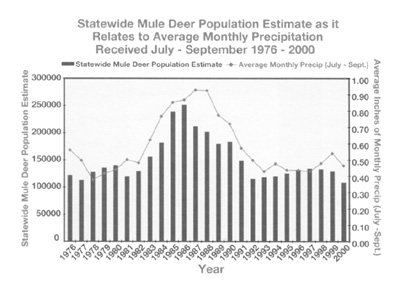

In addition to drought, factors like fire, development, highway corridors and fencing, and other alterations to Nevada's native habitats are taking their toll, according to a recently completed report.
"Nevada's Mule Deer, Population Dynamics: Issues and Influences," is a recently completed in-depth study of Nevada’s mule deer populations by Tony Wasley, Nevada Department of Wildlife (NDOW) Mule Deer Project manager. The bulletin reveals that in the early days of Nevada, before the 1870s, mule deer numbers may have been a small fraction of what they are today. Even though our deer numbers seem low to us now, they’re actually 10-times what they were a century ago.
Wasley's study shows that over the last 25 years the number of deer in the state seems to be directly related to the amount of summer rain. Summer drought negatively affects the quality of summer forage, while good summer rainfall prolongs forage quality, resulting in better deer condition. Good habitat allows for increased fawn production and survival, which makes mule deer populations better able to withstand natural sources of mortality, such as severe weather events and predation.
Wasley’s study shows that the late 1980s wasn’t the mule deer population's first peak. The early 1950s and 1960s saw deer populations peak at an estimated 250,000. At that time the sagebrush ecosystem was younger, and resulted in higher-quality forage component, which deer thrived on.
Buck harvest levels peaked at 14,000 and 15,000 roughly during these time periods. A short dip in the deer population below the 100,000 mark during the mid-1970s prompted the creation of the tag-draw system in 1976.
Human development has also greatly affected mule deer. The growth of towns and cities around Nevada has greatly altered the natural environment. Barriers, such as highways, fences, railroads, guard rails, mines and neighborhoods make deer migrations more difficult and hazardous.
Most hunters ask what we can do to achieve higher numbers of deer. Pray for good summer rain. Nevada is the driest state in the Union and water is key in wildlife management. Without rain and snow to keep creeks running, springs fresh, grasses, forbs and brush tender and green for food and cover, deer numbers dwindle.
There are also some practical things that hunters can do. Work with land management agencies to increase habitat productivity and plant species diversity to benefit all sagebrush-steppe inhabitants. Support sound mule deer management, based on scientific study. Provide input into the Department's mule deer planning effort. Volunteer to help eradicate and control the spread of noxious weeds or collect native seed for fire rehabilitation efforts. Get involved with range rehabilitation and habitat projects that will restore Nevada’s wild lands for everyone’s benefit.
To Nevada hunters, mule deer are a symbol of the state’s rugged and austere beauty, and well worth all the hard work and resources donated by sportsmen.
Copyright © 2004 J & D Outdoor Communications. All rights reserved.